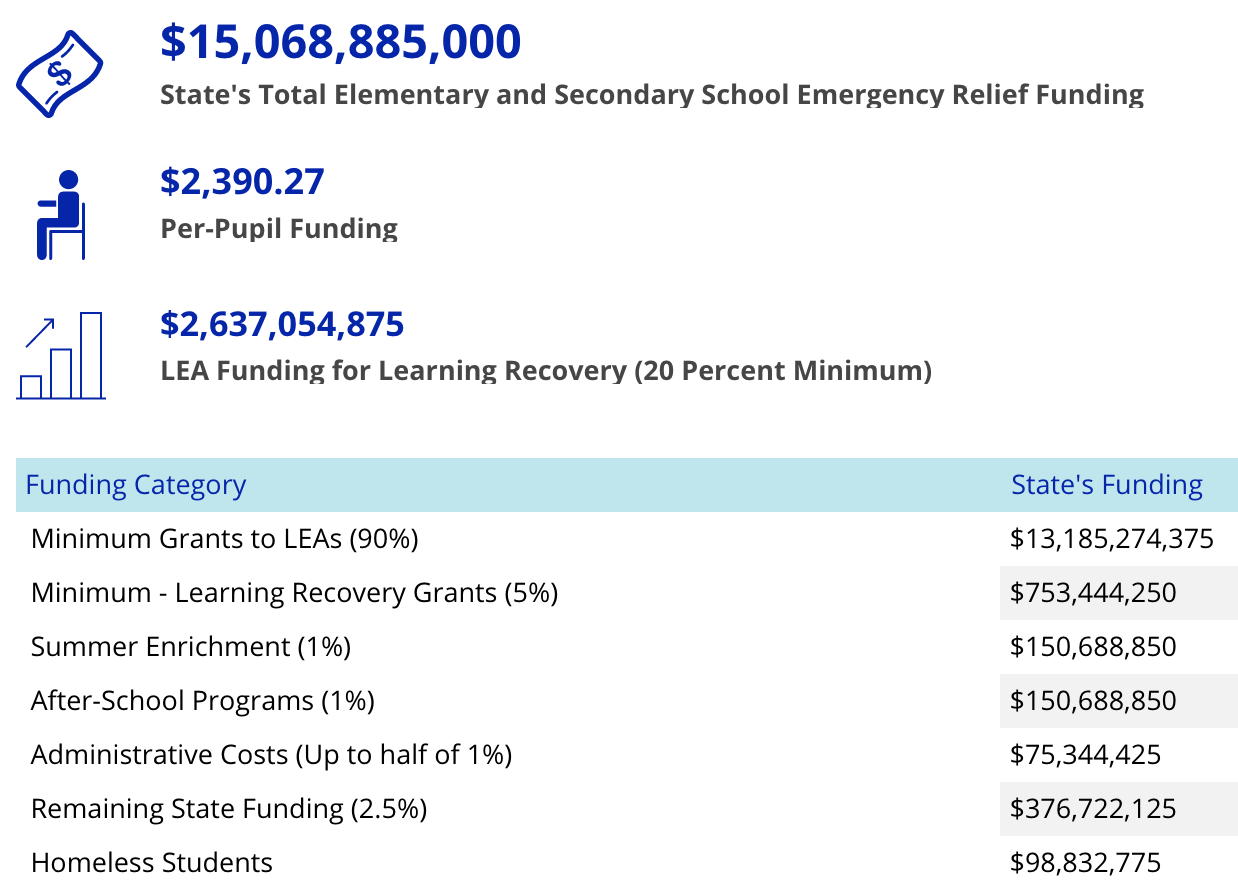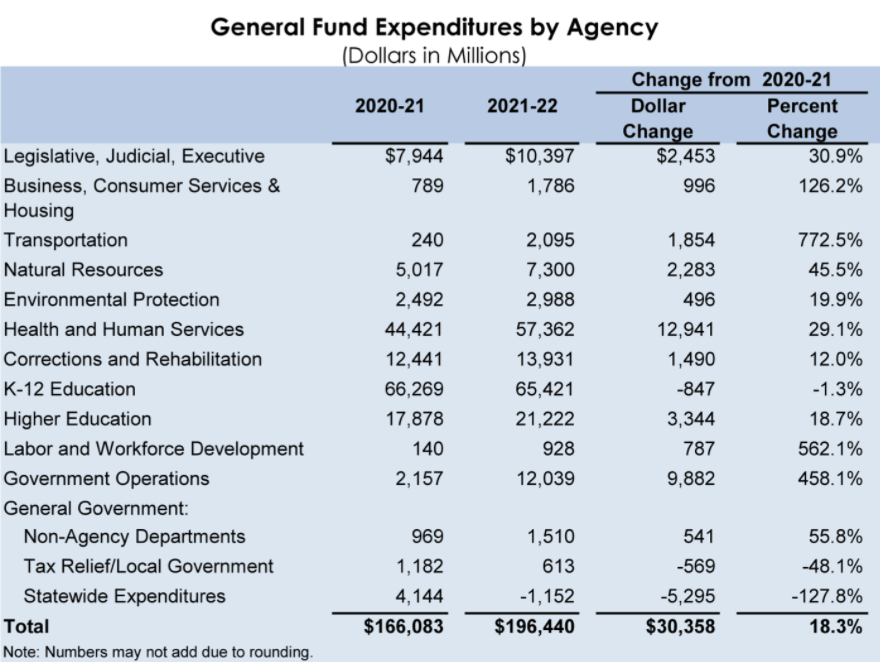A Dream Education Budget for California

Unpacking the California budget box
California’s 2021-22 budget for education reads like a treasure chest of best education practices:
⛶ Universal preschool
⛶ Expanded learning time
⛶ Universal access to school meals for all students
⛶ Additional resources to support at-risk students
⛶ Expansion of community schools
⛶ Investments in high-quality teachers
⛶ Additional staff for needy students
These investments have long been on the wish list of many parents and educators. And for good reasons: long-term studies of worldwide education systems identify them as key components associated with long-term success. These practices provide greater equity and learning opportunities, especially for disadvantaged students.
What a difference a year makes, right?
Last year, at the outset of the Pandemic, schools struggled to pay for COVID-related costs and the state faced a $54 billion budget deficit. This year, growing state tax revenues and huge investments from the federal government turned that stark picture around.
Record education funding
Total Education Funding. It’s often said that budgets are an expression of values, but they are also an exercise in forecasting and risk assessment. Each year’s budget is based on official educated guesses about the amount of money that will be collected in taxes and fees from multiple sources, from property taxes to lottery ticket sales. This year's budgeted funding for all K-12 education programs is the highest level in California's history. The combination of $65.5 billion in state funds and a whopping $58.4 billion in federal and anticipated local funds totals $123.9 billion. That’s an average of $21,555 per student. (Federal funding traditionally pays for programs such as child nutrition, special education, and Title I, to improve the academic achievement of the disadvantaged.)
What’s the difference between last year and this year? A lot. Last year, total overall funding (federal, state, and local) for all K–12 education programs was $98.8 billion, with per-pupil spending of $16,881 in 2020–21.
|
California K-12 public education funding |
||||
|---|---|---|---|---|
|
Fiscal Year |
State Funds |
Federal + Local Funds |
Total Funds |
Per Pupil |
|
2020-21 |
$48.1 billion |
$50.7 billion |
$98.8 billion |
$16,881 |
|
2021-22 |
$65.5 billion |
$58.4 billion |
$123.9 billion |
$21,555 |
The big funding bump for education this year is due not only to increased state revenues but also in large part to quick action by the President and Congress to provide more resources to states in response to the Pandemic.
State Education Funding. State per-pupil funding this year under Prop. 98 is $13,976. Last year, Prop. 98 funding was $10,654. Additional federal relief and other supplementary state spending augmented this funding.
The Federal Government to the Rescue. Last year the state gave schools extra money above the legal minimum to keep schools from cratering. The money came from reductions in other state programs. California would still be struggling were it not for the huge amounts of federal help. The American Rescue Plan provides $26 billion in fiscal relief for the state and $16 billion for local governments, and most of it ($15 billion) is going to schools.
Putting it all together. So how much will your district actually get in combined relief funding from different sources? EdSource developed district-by-district estimates. The Learning Policy Institute sums it up:

Pay Back Time: Deferrals
Last year, state revenue estimates were so low that the state deferred payments to school districts. In plain language that means local school districts weren’t paid on time. Districts had to use their reserves or borrow to meet expenses. This year, unexpectedly higher state revenues bring smiles to the faces of school district budget managers. All those IOUs totalling $11 billion are paid off in this budget to schools and community colleges.
It’s also time to pay back money owed to the state general fund, the largest portion of the state budget. Last year, budget cuts to the non-education side of the budget helped support schools. The increased state revenues plus the federal funding for schools gives California the wiggle room to invest a lot more of its state money to support other important non-education programs. The table below shows the large increases in spending compared to education funding:

Budget rule of thumb: Use one-time money for one-time expenses
Below is a quick summary of major state education investments in the California 2021-22 Enacted Budget. A lot of the money, especially including federal Covid relief funds, is what budget nerds call one-time revenue. A budget rule of thumb is that one-time money should be used for one-time expenses, not for ongoing operations. For example, don’t spend one-time money to hire permanent staff that will need to be paid ongoing salaries when the one-time money goes away. Using one-time money for emerging, experimental or temporary programs can help avoid painful future cuts to ongoing programs.
|
California Education Budget 2021-22 by the numbers |
|
|---|---|
|
Funding Topic |
Amount |
|
California per-pupil funding under Prop. 98 Learn more on Ed100: |
$13,977 in 2021-22 $10,654 in 2020-21 (last year) |
|
LCFF funding The budget includes a compounded LCFF cost-of-living adjustment of 4.05 percent, representing a 2020-21 cost-of-living adjustment of 2.31 percent and a 2021-22 cost-of-living adjustment of 1.7 percent. Additionally, to help local educational agencies address ongoing fiscal pressures, the budget includes $520 million Proposition 98 General Fund to provide a 1-percent increase in LCFF base funding. This discretionary increase, when combined with the compounded cost-of-living adjustment, results in growth in the LCFF of 5.07 percent over 2020-21 Learn more on Ed100: |
Cost of Living Adjustment (COLA): The budget includes an adjustment of 5.07 per cent. Total cost: $66.7 billion |
|
Universal Transitional Kindergarten By the 2025-26 school year, all California four-year olds will have an option to attend preschool in the year before kindergarten, including a Universal Transitional Kindergarten option in all local school districts. Proposition 98 General Fund money beginning in 2022-23 will provide one additional certificated or classified staff person in each transitional kindergarten classroom, reducing adult-to-child ratios from 1:24 to 1:12. To the extent that additional funding is provided, beginning in the 2023-24 school year, these ratios could be further reduced to 1:10. |
$600 million General Fund in 2022-23, growing to $2.7 billion in 2025-26. The Proposition 98 Guarantee will be “rebenched” to draw down the General Fund for the costs of new enrollment in each year of increased investment. Additionally, the Budget includes $200 million one-time Proposition 98 General Fund for planning and implementation grants for all local educational agencies and $100 million one-time Proposition 98 General Fund for local educational agencies to train and increase the number of early childhood educators. |
|
Expanded Learning Expanded Learning programs fund afterschool and summer school enrichment. Full-year instruction and enrichment for all elementary school students will go to local educational agencies with the highest concentrations of low-income students, English language learners, and youth in foster care. By 2025-26, these students would have access to no-cost after school and summer programs. Learn more on Ed100: |
$1 billion ongoing Proposition 98, and $753.1 million one-time Proposition 98 funds, growing to $5 billion ongoing Proposition 98 funding at full implementation for all classroom-based local educational agencies. |
|
Universal School Nutrition Beginning in the 2022-23 school year, all public schools will be required to provide two free meals per day to any student who requests a meal, regardless of income eligibility. Learn more on Ed100: |
The state will cover any remaining unreimbursed costs up to the federal free per-meal rate, at an estimated cost of $650 million Proposition 98 General Fund annually. Additionally, the budget provides $150 million one-time Proposition 98 General Fund for school districts to upgrade kitchen infrastructure and equipment, as well as provide training to food service employees |
|
Community Schools Funding in the 21-22 budget will support grants for up to 1,000 local educational agencies to convert school campuses into full-service community schools. Community schools partner with education, county, and nonprofits to provide integrated health, mental health, and social services alongside high-quality, supportive instruction Learn more on Ed100: |
$2.8 billion One-time Proposition 98 General Fund, available over several years. |
|
Increased Student Services Additional student support eg counselors, nurses, teachers, paraprofessionals Learn more on Ed100: |
$1.1 billion ongoing for districts with high concentrations of high-needs students |
|
Early Care and Education. Child Care Slots. Increases child care access by 200,000 slots – beginning with 120,000 in 2021-22 and phasing in an additional 80,000 over the next four years. Prioritizes ongoing vouchers for essential workers currently receiving short-term child care. Child Care Rate Reform. Increases all direct-contract childcare and preschool program rates. Provides a variety of one-time investments to stabilize child care providers growing out of the pandemic, including stipends and hold-harmless policies. |
Provides $250 million in one-time investments in child care facilities ($100 million in federal funds, and $150 million in General Fund) |
|
Youth Behavioral Health Modern and innovative behavioral health system for youth ages 0 to 25, including $205 million for the Mental Health Student Services Act to fund school and county mental health partnerships to support the mental health and emotional needs of children and youth as they return to schools and everyday life. |
$4.4 billion dollars over five years |
|
Educator Retention, Preparation and Training Learn more on Ed100: |
$2.9 billion in total one-time for a wide variety of programs. See p 49 of the state Budget Summary. |
|
Special Education The budget includes an increase in the base rate for special education funding, support for 3-5 year olds and investments in dispute resolution and learning recovery supports associated with the Pandemic. Learn more on Ed100: |
$396 million in ongoing Proposition 98 General Fund to increase the statewide base rate for the special education formula and $260 million ongoing Proposition 98 to fund specified services for children ages 3-5 years old. In addition, one-time funds of $550 million Proposition 98 are provided to invest in increased support for special education alternative dispute resolution and learning recovery supports for special education students associated with impacts due to the COVID 19 pandemic. |
|
Broadband: Close Digital Divide The budget reflects a plan to increase equitable access to high-speed broadband Internet service through a $6 billion investment to expand broadband infrastructure and enhance access by constructing an open access middle mile and by funding construction of last mile projects that connect unserved households in remote areas to the middle mile network. Learn more on Ed100: |
$6 billion total $3.25 billion of one-time federal ARPA funds for “middle mile” network $2 billion over three years from a combination of one-time federal ARPA Funds and General Fund for “last-mile” service. |
|
Child Savings Accounts for low income students The budget establishes college savings accounts and funds $500 base deposits for all public school students from low-income families, English learners, and foster youth. The value of these deposits will grow over time, providing additional support for postsecondary education. New accounts will also be created for each subsequent incoming class of low-income first graders. |
$1.9 billion in 2021-22 ($1.8 billion one-time federal American Rescue Plan Act of 2021 funds, $91.7 million one-time General Fund, and $16 million ongoing General Fund) and reflects an additional $170 million ongoing General Fund beginning in 2022-23, to establish college savings accounts for all current low-income public school students. |
Tags on this post
Budgets Funding PlanningAll Tags
A-G requirements Absences Accountability Accreditation Achievement gap Administrators After school Algebra API Arts Assessment At-risk students Attendance Beacon links Bilingual education Bonds Brain Brown Act Budgets Bullying Burbank Business Career Carol Dweck Categorical funds Catholic schools Certification CHAMP Change Character Education Chart Charter schools Civics Class size CMOs Collective bargaining College Common core Community schools Contest Continuous Improvement Cost of education Counselors Creativity Crossword CSBA CTA Dashboard Data Dialogue District boundaries Districts Diversity Drawing DREAM Act Dyslexia EACH Early childhood Economic growth EdPrezi EdSource EdTech Education foundations Effort Election English learners Equity ESSA Ethnic studies Ethnic studies Evaluation rubric Expanded Learning Facilities Fake News Federal Federal policy Funding Gifted Graduation rates Grit Health Help Wanted History Home schools Homeless students Homework Hours of opportunity Humanities Independence Day Indignation Infrastructure Initiatives International Jargon Khan Academy Kindergarten LCAP LCFF Leaderboard Leadership Learning Litigation Lobbyists Local control Local funding Local governance Lottery Magnet schools Map Math Media Mental Health Mindfulness Mindset Myth Myths NAEP National comparisons NCLB Nutrition Pandemic Parcel taxes Parent Engagement Parent Leader Guide Parents peanut butter Pedagogy Pensions personalized Philanthropy PISA Planning Policy Politics population Poverty Preschool Prezi Private schools Prize Project-based learning Prop 13 Prop 98 Property taxes PTA Purpose of education puzzle Quality Race Rating Schools Reading Recruiting teachers Reform Religious education Religious schools Research Retaining teachers Rigor School board School choice School Climate School Closures Science Serrano vs Priest Sex Ed Site Map Sleep Social-emotional learning Song Special ed Spending SPSA Standards Strike STRS Student motivation Student voice Success Suicide Summer Superintendent Suspensions Talent Teacher pay Teacher shortage Teachers Technology Technology in education Template Test scores Tests Time in school Time on task Trump Undocumented Unions Universal education Vaccination Values Vaping Video Volunteering Volunteers Vote Vouchers Winners Year in ReviewSharing is caring!
Password Reset
Search all lesson and blog content here.
Login with Email
We will send your Login Link to your email
address. Click on the link and you will be
logged into Ed100. No more passwords to
remember!














Questions & Comments
To comment or reply, please sign in .